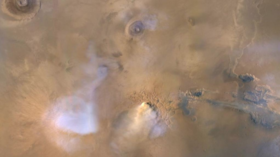Gargantuan ‘dust towers’ may have STRIPPED Mars of all its water, says NASA

Roughly once a decade, Mars experiences an extremely violent, planet-wide storm that covers the entire surface with continent-sized dust towers. NASA now thinks this phenomenon may be what stripped the planet of its water.
According to two new papers, a fleet of NASA spacecraft monitored the Red Planet throughout 2018 including NASA's Mars Reconnaissance Orbiter (MRO) which peered through the dusty haze formed by these violent tempests (including the storm which ended the Opportunity Rover's mission), using its heat-sensing Mars Climate Sounder instrument.
Using the MRO’s readings, combined with images from the Mars Context Imager (MARCI) on board an orbiter above the planet, the space agency was able to directly observe massive dust towers forming and dissipating across the Martian surface.
Also on rt.com Ready to risk getting cancer or dementia to set foot on Mars? Main health concerns on your way to the Red PlanetThese ‘dust towers’ are concentrated pillars of dust which have been shown to eject water vapor off-world and into space, acting like a form of uncontrollable space elevator. As the airborne dust heats up, it creates strong updrafts which carry gases and water vapor up and out of the atmosphere, at which point solar radiation breaks the water molecules apart.
This process may provide a key clue as to how the Red Planet was stripped of its vast lakes and rivers over billions of years.
The dust towers occur in normal conditions throughout the year, but seem to intensify during these once-in-a-decade planetwide storms.
They are truly vast in size, beginning with a base that stretches approximately as wide as the US state of Rhode Island (37 miles) and reaching heights of up to 50 miles (80km) where they can expand to the width of Nevada (320 miles). As the tower destabilizes the resulting dust layer stretches out as wide as the continental US.
Also on rt.com Ancient aliens? NASA’s Mars 2020 mission landing site could contain fossilized signs of life“Normally the dust would fall down in a day or so,” said the paper's lead author, Nicholas Heavens of Hampton University in Hampton, Virginia. “But during a global storm, dust towers are renewed continuously for weeks.”
In fact, some of the towers lasted for as long as three and a half weeks before eventually crashing back down to Mars.
Think your friends would be interested? Share this story!












